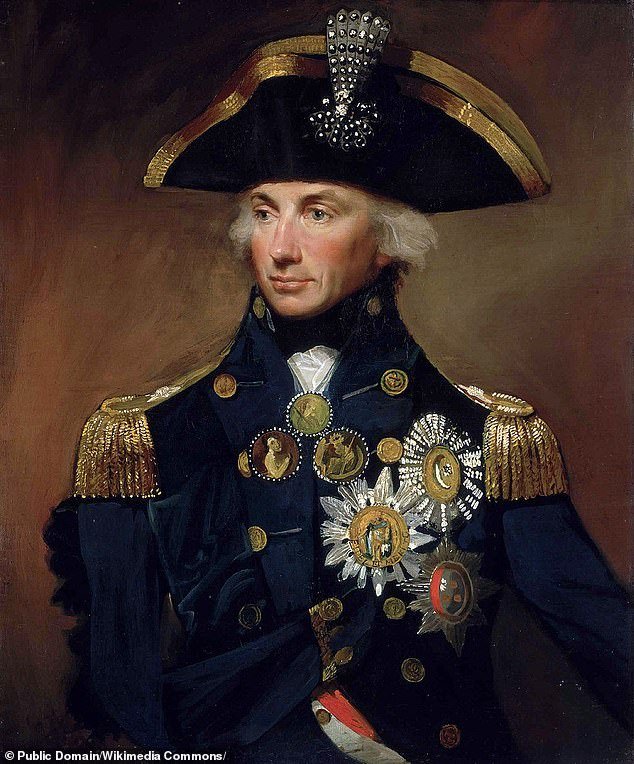A prestigious gallery has said Admiral Lord Nelson was ‘queer’, it has been revealed.
The British naval hero died for his country after he masterminded his greatest triumph over the French and Spanish fleets at the Battle of Trafalgar on October 21, 1805.
He was fatally shot in 1805 during the Battle of Trafalgar, in which the Royal Navy triumphed over the combined forces of France and Spain.
The taxpayer-funded Walker Art Gallery in Liverpool displays two paintings of Nelson which show his final moments aboard the HMS Victory.
It is generally believed that Nelson’s famous last words were ‘kiss me Hardy’, which he uttered to Vice-Admiral Sir Thomas Hardy, his flag captain.
In response Lord Nelson received a kiss from Hardy on his hands and forehead, it has been said.
But a letter sent by a comrade six days after the battle provides a different account.
Despite the admiral’s several affairs with women, curators have placed him in a ‘Queer relationships’ collection at the gallery.

A prestigious gallery has said Admiral Lord Nelson was ‘queer’
Artwork of Nelson’s death have also been added online to an article about the ‘history of LGBTQ+ love’, according to the Telegraph.
Online information from the gallery, which is part of the publicly funded National Museums Liverpool group, states: ‘Historians have speculated about the exact nature of the relationship between Hardy and Nelson.
‘Regardless of the truth, for many, Nelson’s famous request is symbolic of the sometimes hidden queer history of life at sea.’
It adds: ‘Whether or not their relationship was sexual remains unknown, but their friendship is reflective of the close relationships formed between men at sea.
‘Intimate relationships, both sexual and platonic, could develop between those on board.’

Daniel Maclise’s The Death of Nelson, 1805, is on display at the Walker Art Gallery in Liverpool in the ‘Queer relationships’ collection
George Sievers, master at arms on HMS Belleisle – which was second in the British column – disclosed that Nelson stayed alive long enough to ‘be informed of the extent of the glorious victory he had gained’.
Sievers said Nelson uttered the emotive final words: ‘Thanks be to God but I have lived this day and now I die content.’
Sievers wrote from Gibraltar on October 27, 1805: ‘Lord Nelson in the Victory engaged the French Admiral most closely, during the heat of the action his Lordship was wounded with a grapeshot in the side and was obliged to be carried below.
‘Immediately on his wound being dressed he insisted again on being brought on Deck when shortly afterward he rec’d [received] a shot through his body he survived however till the evening: long enough to be informed of the capture of the French Admiral and of the extent of the glorious victory he had obtained.
‘His last words were Thanks be to God I have but lived this day and now I die content.’
It comes as a previously unknown portrait of what could have been William Shakespeare’s gay lover has been revealed.
The miniature portrait, painted on the back of a playing card, could be an intimate painting of the playwright’s patron and paramour.
On the reverse of the token, a red heart of a playing card is visible, as is a large black arrow – a motif which also appears in the playwright’s personal coat of arms.

The portrait of an androgynous figure depicts Henry Wriothesley, the third Earl of Southampton and was likely given to William Shakespeare as a love token
Dr Elizabeth Goldring, an art historian and honorary reader at the University of Warwick, revealed the 16th-century painting was probably a love token with great emotional significance to the owner.
The portrait of an androgynous figure depicts Henry Wriothesley, the third Earl of Southampton.
Painted by Queen Elizabeth I’s favourite portraitist, Nicholas Hilliard, the artwork was created in the 1590s.
The time period overlaps with the poet’s two erotic poems – Venus and Adonis (1593) and The Rape of Lucrece (1594) – both dedicated to the Earl.

